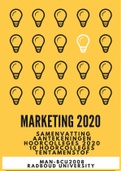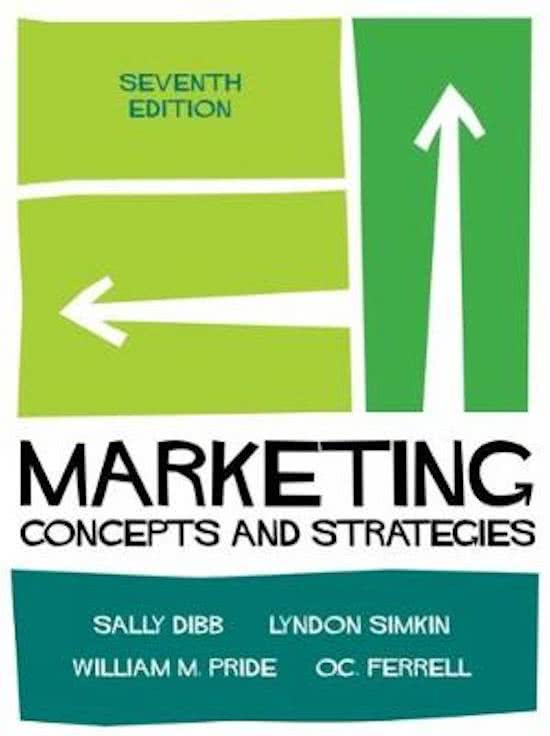,Inhoud
Introduction to this document .......................................................................................................................... 3
Part 1 – Marketing defined and marketing in context ........................................................................................ 3
Lecture 1 – Introduction (Chapter 1) ............................................................................................................. 3
Chapter 1 The marketing concept ............................................................................................................. 3
Lecture 2 – Market Structure and competitor analysis (Chapter 2, 3) ............................................................. 4
Chapter 2: Marketing strategy and understanding competitors ................................................................. 6
Chapter 3: The marketing environment .................................................................................................... 7
Part 2 – Understanding and targeting customers ............................................................................................... 7
Lecture 3 – Segmenting, targeting, positioning (Chapter 7,8)......................................................................... 7
Chapter 7 Segmenting markets ............................................................................................................... 10
Chapter 8 Targeting and positioning ....................................................................................................... 11
Lecture 4 – Research questionnaires (Chapter 9) ......................................................................................... 11
Chapter 9 Marketing research ................................................................................................................ 12
Lecture 5 – Buying behaviour (Chapter 5+6) ................................................................................................ 13
Chapter 5 Consumer buying behaviour ................................................................................................... 15
Chapter 6 Business Markets and Business buying behaviour ................................................................... 15
Part 3 – Marketing programmes...................................................................................................................... 17
Lecture 6 – Branding (Chapter 11)............................................................................................................... 17
Chapter 11 Branding and packaging ........................................................................................................ 18
Lecture 7 – New product development + Pricing (Chapter 10,12,20)............................................................ 19
Chapter 10 Product decisions ................................................................................................................. 21
Chapter 12 Developing products and managing product portfolios ......................................................... 22
Chapter 20 Pricing .................................................................................................................................. 23
Lecture 8 – Marketing communication (Chapter 16,17,19) .......................................................................... 24
Chapter 16 Marketing communication .................................................................................................... 25
Chapter 17 Advertising, public, relations and sponsorship....................................................................... 26
Chapter 19 Digital marketing .................................................................................................................. 26
Lecture 9 – Marketing channels (Chapter 14,15,18)..................................................................................... 27
Chapter 14 Marketing Channels.............................................................................................................. 29
Chapter 15 Channel players .................................................................................................................... 30
Chapter 18 Sales management ............................................................................................................... 30
Part 4 – Marketing management ..................................................................................................................... 31
Lecture 10 – Marketing & society (Chapter 24)............................................................................................ 31
Chapter 24 Responsible marketing.......................................................................................................... 32
Information for the exam............................................................................................................................ 33
Bonus bijlage: Een boodschap voor jou – een actueel verhaal ......................................................................... 34
,Introduction to this document
This document contains a summary from all the marketing lectures and all the relevant chapters
from the book: Marketing, concepts and strategies. The author watched 100% of the lectures and red
all the summary’s in the book and more summaries. All content is exam relevant.
Part 1 – Marketing defined and marketing in context
Lecture 1 – Introduction (Chapter 1)
Chapter 1 The marketing concept
Marketing = Marketing’s primary aim is the identification of target markets and the satisfaction of
these customers, now and in the future. Marketers should strive to be the radar or ears and eyes of
their organization’s product or service.
Most important tasks of marketing:
- Understanding markets and develop insight in these markets
- Shaping an organization strategy in terms of selection of opportunities
- Creating brands and brand value propositions
- Managing customer experience
Marketing environment = External changing forces within the trading environment; laws,
regulations, political activities, societal pressures, economic conditions and technological advances.
Myth: Marketing is selling. “The aim of marketing is to know and understand the customer so well
the product or services fits him and sells itself.”- Peter Drucker
Myth: Marketing is Communication. Communication is not the goal, just a way.
Myth: Marketers Create Needs
“Marketing is the activity, set of institutions, and processes for creating, communicating, delivering
and exchanging offerings that have value for customers, clients, partners and society at large.”
The book is talking about satisfying exchange relationship.
Marketing mix = Product, Price, Promotion (all communication), Place (Distribution) – Some add:
People. Place becomes less important, because of the digital world.
Exchange relationship
For the exchange to take place, four conditions must exist:
1. Two or more individuals
2. Each party must possess something of value that the other party desires
3. Each party must be willing to give up his thing of value, in exchange
a. Objective of marketing is make an profitable exchange.
4. The parties must be able to communicate
Marketing focus on goods, services and idea’s.
Evolution of the marketing concept
1. Production era: Mass production
, 2. Sales era: 1920-1950, competitive forces and desire led a company to emphasize selling and
sales in the business strategy.
3. Marketing era: 1950+ Customers needs where identified and satisfied.
4. Relationship marketing era
5. Digital era
6. Consumer-to-consumer marketing
7. Social marketing
Critical marketing = Involves challenging orthodox vies that are central to the core principles of the
discipline.
Marketing management = This is the process of planning, organizing, implementing and controlling
marketing activities to facilitate and expedite exchanges effectively and efficient.
Marketing planning = The systematic process of assessing marketing opportunities and resources
determining marketing objectives and developing a thorough plan for implementation and control.
An effective control process has the following requirements:
- Actual and planning
- Monitor different kinds
- Must be low of costs
- Managers and subordinates must understand it
Lecture 2 – Market Structure and competitor analysis (Chapter 2, 3)
Lecture
Environmental analysis and SWOT
It is important that you only highlight the things that are relevant to the company.
There is also used SWOT analysis. The whole idea of the SWOT is to compare the internal and
external part of the world.
! There is a part in the book, about what we can do with the SWOT.
Common problems with the SWOT:
, - Opportunities are external issues, not choice options... (For example: Growing economy of
Iran)
- Rank items in order of importance, avoid making long lists.
- Be specific and support each item with evidence.
- Avoid being overly optimistic. It is good to know what you are not good at.
- Try to make the company in the market with the closest competitors. (Who are my
competitors?)
Market Structure analysis
Do we have competition? There is no such thing as a business without competition.
Current competition and future competitors.
Why are we doing market structure analysis and competitor analysis?
- Allows firms to determine which other marketing offers are competing.
- Crucial to the Value proposition and to have a good marketing mix: A statement that
convinces someone to buy the certain product/service.
- Allows firms to be proactive
Defining the market
Make sure that you have a clear view on the market: Who is you direct, or indirect competitor, who
threatens the market share, who is trying to offer a similar value offer? Satisfying the same need?
Who is competing for the same budget?
What are competitors
Competitors: Organizations that are viewed as marketing products similar to, or substitutable for, a
company’s products, when targeted at the same customers.
It is important to Identifying competition in a good way. New product forms can become key to
competitors. And also in order to identify our proper market share.
Market share = (us/us + them)
Methods of identifying competitors
- Demand-based approach – looks at the customer value.
- Supply-based approach
Competition really depends on the form and degree (Like competition between brands, or products
with a certain feature, product type, product types and between different household appliances).
Demand models - Four levels of competition:
1. Product form competition (the same product) – The best quality/price
2. Product class/category (Products with similar features – provides the same basic function). –
Our product form is the best.
3. Generic competition: Fullfilles the same needs. – It is nice to have a warm drink.
4. Budget competition – We need to explain that you can better spend your money on good
coffee maker than a good oven.
“An industry should be recognizable for a group of products that are close substitutes to buyers –
they are available to a common group and are distant substitutes for all product not included in the
industry.”
Empirical model:
- Focus group
- For example: Scanner data. (Bonus cards etc.)
,Supply-based Methods:
- Observation
- The European classification System, NACE code, to see where you are companies are in.
But not all participants in a market are competitors. There are all kinds of collaborations.
- Ecosystem -> Trying the build a community and that you need to buy their products.
- Value Chain -> Suppliers for example, when others are doing well, you are.
- Open Innovation
- Co-creation
Competitors’ Roles in the Marketplace
- Market leader: The single best player
- Market challenger: The ones who aggressively attack the market leader
- Market followers: Not so big
- Fast movers: Small companies – but with a very big potential
- Niche players: Target at a very specific group
Competitor Analysis:
Objectives: What are they after?
Strategy: How are they trying to achieve it? (This can be seen by the marketing communications)
Strengths & weaknesses: How are they at finance, manage etc.
Matchup: Define key success factors.
Expected Future Strategy: We can make a prediction where the competitors are going.
Tools to use: Simulation, role-playing or scenario planning.
Difference between primary and secondary information sources
Secondary Information Sources: Made for another purpose than for your research. Internal Sources,
Annual Report, Trademark, General Business publications, Consultant, Wanted Advertisements,
Electronic Data Services.
Primary Information sources: Made in your research. Sales, Employees, Suppliers, Trade shows,
Reverse engineering, Plant tours, Blogs & Internet Newsgroups.
Chapter 2: Marketing strategy and understanding competitors
Marketing strategy = The selection of new opportunities to pursue and current activities to support,
identification of associated target markets and competitive positioning and creation of value
proposition and customer engagement plans, in order to deliver the specified performance goals in
the corporate strategy.
Marketing and corporate strategy are very close aligned.
, There are three major considerations in assessing opportunities and resources to build up a
sustainable differential advantage:
1. Evaluating marketing opportunities
2. Environmental scanning
3. Understanding the organization capabilities and assets
Ansloff Matrix = Assist in decision-making by strategic objectives.
1. Intense growth = Either old product or old market
2. Diversified growth = New product/New market
3. Integrated growth = Merger and acquisition
Porter – generic routes to competitive advantage:
- Cost leadership
- Differentiation
- Focus
You can either have a defensive or offensive market position.
Differential advantage = An attribute of a brand, product, service or marketing mix that is desired by
the targeted customer and provided by only one supplier; a unique edge over rivals in satisfying this
customer.
Chapter 3: The marketing environment
Roughly two categories: Micro and macro
Macro environment = Consist of six categories: Political, Legal, Regulatory, Societal, Technological,
Economic.
For this chapter, make sure where all the different segments consists of (for most of us, I
think it is clear because you have had it in another course)
Micro environment = Situation and organization specific forces. This consists of the organization,
suppliers, marketing intermediaries, buyers, competitors, publics.
Strategic windows = When changes occur in the marketing environment they can trigger major
developments. Of large enough, such changes are strategic windows or paradigm shifts. This can be
trough technology, markets, new distribution channels etc.
Part 2 – Understanding and targeting customers
Lecture 3 – Segmenting, targeting, positioning (Chapter 7,8)
Segmenting: Segmenting the market in different targets groups. Personas
Targeting: Select market from promising segments
Positioning: Choosing a certain positioning, through targeting and segmenting.
Mass marketing/Traditional marketing. Idea: One size fits for all and there is one type of
communication.
Scale economy
Lower prices, higher margins, low communication costs.
But: There came more competitors, which made it hard to further practice “one fits for all” approach.
Key ideas:





